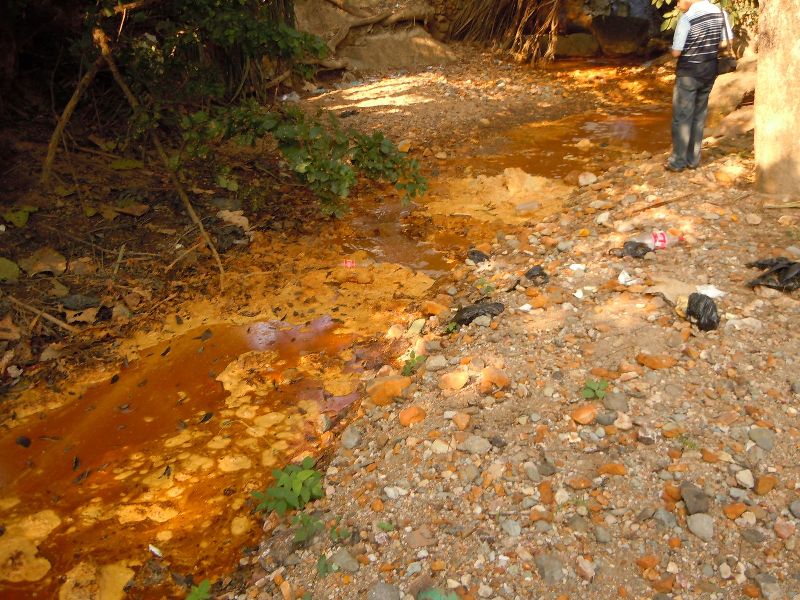While There is a Slight Increase in Water Quality, the Situation is still Critical
River Water Quality Improves, says MARN
The water classified as ŌĆ£goodŌĆØ in rivers increased 2 per cent, to 12 percent in 2011.┬Ā
By Gloria Mor├Īn
Diario Contra Punto
San Salvador- With its report ŌĆ£River Quality in El Salvador, 2011ŌĆØ the Ministry of the Environment and Natural Resources (MARN) revealed that the water in Salvadoran rivers showed a tendency of improved water quality.
The studies were carried out between April and June of 2011, and the MARN took 123 samples from 55 rivers, including the Paz River, the Grande River in Sonsonate, the Bahia River in Jiquilisco, the Grande River in San Miguel, as well as others.
The information collected showed that none of the rivers had ŌĆ£excellentŌĆØ water quality, that 12 percent had ŌĆ£goodŌĆØ quality, which shows an increase from 10 percent in 2010; that 50 percent had ŌĆ£averageŌĆØ quality; that 31 percent had ŌĆ£poorŌĆØ quality, and 7 percent had ŌĆ£terribleŌĆØ quality.┬Ā One of the major findings is that according to the study the Lempa Rivera improved in water quality in the Northern regions of the country.┬Ā The improved water quality has provided the conditions for the more aquatic life.
The head of the MARN, Herman Rosa Chazez, said that improved water quality can be attributed to the work done by the ministry in sewer and other waste treatment; for example collecting tires, compost sites, and sewer treatment, among others.
Domestic water is the most contaminated
However, he empathized that while it is true that there has been an increase in the river water considered ŌĆ£good,ŌĆØ that is not enough and he affirmed that the Government will invest more resources in treating sewer water.┬Ā
According to Celia Mena, hydrologist with the MARN, this investment is necessary because the water coming from domestic use is the most contaminating to rivers.┬Ā
ŌĆ£This type of pollution can be seen by the presence of high concentrations of Coli form fecal bacteria in the water.┬Ā During the study, there were concentrations of 3,500,00 bacteria/100 mL found,ŌĆØ says the MARN report.┬Ā Celina affirmed that ŌĆ£the water quality of the majority of rivers is deficient for conventional potable water standards,ŌĆØ referring to the fact that only 17 percent of river water can be made drinkable by taking steps like adding bleach, boiling or filtering water. ŌĆ£The quality of river water is improving,ŌĆØ said Rosa Chavez, when he compared the results with those in 2009 where none of water could be classified as ŌĆ£goodŌĆØ.
Other Results
Other results found by the study were that only 26 percent of river water can be used for crop irrigation.
Of the 123 sample sites on a national level, only 26% met irrigation standards, ŌĆ£the other 74% donŌĆÖt meet the requirements for irrigation due to the high levels of fecal Coli forms, with conductivity levels up to 1319 uS/cm and some areas with elevated levels of sodium and sulfates.ŌĆØ
According to the study, the rivers that meet irrigation standards are the Lempa River and the San Sim├│n River that provide water for the Lempa Acahuapa Irrigation District. While those which didnŌĆÖt meet the standards are the Sucio River which supplies the Zapotitan Irrigation District with water, the Lempa River in the Northern District and the Acahuapa River that supplies the Lempa Acahuapa District.┬Ā
The study showed poor water quality for recreational activities, indicating that only 0.08 percent can be used for recreation, while in 2010 the report showed that 6 percent was adequate for recreation.
ŌĆ£This is not a new situation [the river pollution] and that is why we need more investment and commitment from the Government,ŌĆØ said the head of MARN.

┬Ā
┬Ā
